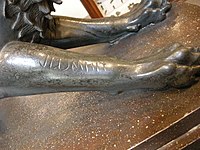Tinia
| Tinia | |
|---|---|
 Terracotta bust of Tinia from 300–250 BCE | |
| Symbol | Thunderbolt, eagle, ivy wreath |
| Personal information | |
| Consort | Thalna or Uni |
| Children | Hercle and Menrva |
| Equivalents | |
| Greek equivalent | Zeus |
| Roman equivalent | Jupiter |
| Egypt equivalent | Amun |

Tinia (also Tin, Tinh, Tins or Tina) was the god of the sky and the highest god in Etruscan mythology, equivalent to the Roman Jupiter and the Greek Zeus.[1] He was the husband of Thalna or Uni and the father of Hercle.
The Etruscans believed in Nine Great Gods, who had the power of hurling thunderbolts; they were called Novensiles by the Romans.[2] Of thunderbolts there were eleven sorts, of which Tinia, as the supreme thunder-god, wielded three.[2] Tinia was also part of the powerful "trinity" that included Menrva and Uni, and had temples in every city of Etruria.[3] Tinia was sometimes represented as seated and with a beard or sometimes standing and beardless.[3] In terms of symbolism, Tinia has the thunderbolt and the rod of power, and is generally accompanied by the eagle and sometimes has a wreath of ivy round his head, in addition to the other insignia of Jove.
Some of Tinia's possible epithets are detailed on the Piacenza Liver, a bronze model of a liver used for haruspicy. These inscriptions have been transcribed as Tin Cilens, Tin Θuf and Tinś Θne. There have been a number of suggestions as to their meaning, but the Etruscan language is poorly understood and there is no scholarly consensus for the translation.
Inscriptions
Tinia appears in several inscriptions, including:
- Itun turuce venel atelinas Tinas cliniiaras.
- This has given Venel Atelinas for the sons of Tin (ie: The Dioscuri[4])
- On the bronze Chimera of Arezzo:
- Tinscvil
- A gift to Tinia
References
- ^ de Grummond, Etruscan Myth, Sacred History and Legend, page 53
- ^ a b Dennis, George (1848). The cities and cemeteries of Etruria: Vol.I. London.
- ^ a b von Döllinger, Johann Joseph Ignaz (1862). The Gentile and the Jew: Vol.II. London.
{{cite book}}: CS1 maint: location missing publisher (link) - ^ Giuliano Bonfante and Larissa Bonfante (1983). The Etruscan language: an introduction. Manchester University Press.
{{cite book}}: CS1 maint: location missing publisher (link)



